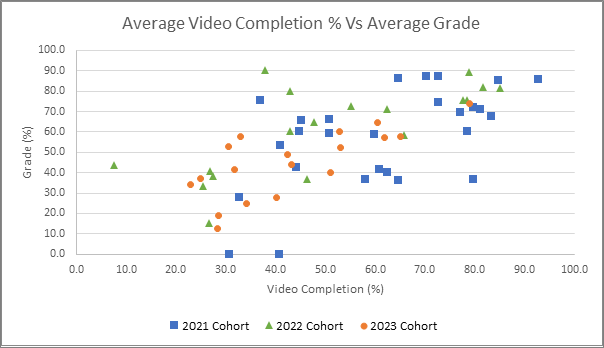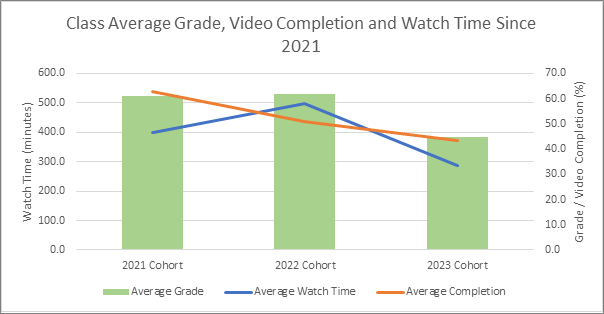What inspired or motivated you to use this tool/resource?
I wanted to understand engagement trends within product design students as part of my stage 2 PGCertTHE, specifically when learning via video-based instruction to gain digital graphics skills. I had noticed that there had been a drop in attainment within classes being delivered via video and wanted to understand both the extent of this drop and what can be done to improve both engagement and attainment.
What was your aim in using this tool/resource?
By using Panopto, my aim was to use the inbuilt learner analytics to gain an understanding of viewing/engagement trends and compare the data with academic attainment and student survey results. The aim once the data was gathered and analysed was to make improvements to the format and delivery of video-based instruction within Product Design.
What did you use the tool/resource for?
The main metrics gathered from Panopto were watch time and video completion for each student. This data can be exported from Panopto with the right level of access, but in my case, I ended up manually entering the data. The data was then compared with academic results which indicated a correlation between watch time and grade and video completion and grade. There was also a noticeable decline in watch time and completion over the past 3 years suggesting that viewing habits have changed. The data gathered helped form the basis for an in-depth student survey and further discussion before creating a pilot series of videos.

How did the tool/resource impact your teaching?
The use of Panopto to deliver video-based instruction has enabled me to monitor and review engagement with video content and provided key metrics to understand how my students are using the platform. When combined with feedback from the students, a revised format of videos was released for student review.
The changes included: ·
- A shorter overall length ·
- Use of chapters and bookmarks within Panopto to segment video ·
- A written guide to support each video to satisfy diverse learning needs ·
- A quicker overall pace of instruction
The changes made had a significant impact on both student engagement and satisfaction with the material. Data from the survey following the pilot series of video indicated learners had a strong preference for shorter videos, found them easier to engage with and were useful in developing their skills. By taking time to analyse historical data and understand what students want, I have been able to refine my workflow. Having a written guide to support a video essentially becomes the script for the video, meaning less cuts and retakes.
How well did the tool/resource perform, would you recommend it?
As a video delivery platform, Panopto is great because it links up with your modules in Blackboard. The platform itself is easy to navigate for both staff and students and features built in multi-language captioning. When recording within the platform it is unobtrusive but, the editing capability is limited being browser based. The built in analytics have been incredibly valuable, although my main criticism would be the auto-generated reports aren’t that useful and I found it easier to just manually transpose the figures I needed – if you have larger class sizes, beware!

How well was the tool/resource received by students?
Changes made and delivered via a pilot series of videos has seen hugely positive feedback from learners, who enjoyed the shorter format, more rapid pacing, written supporting material and navigational aids such as timestamps and contents within Panopto. It is difficult to assess the true impact of the changes made in relation to student’s academic performance and long-term engagement but based of the initial reception from students, they are much more likely to engage with the content in this format which has been proven to correlate with higher grades.
Share a ‘Top Tip’ for a colleague new to the tool/resource
My top tip for video based teaching: Know your audience. Don’t be afraid to discuss with students and find out what they want, either informally or formally. If you are disconnected with what they want and how they learn, they won’t engage with the material. Keep reviewing and iterating your content with informed changes.
How would I summarise the experience in 3 words?
Know your audience.
Recommended reading:
Fyfield, M., Henderson, M., & Phillips, M. (2019). 25 principles for effective instructional video design. ASCILITE Publications, 418-423.
Martin, N. A., & Martin, R. (2015). Would you watch it? Creating effective and engaging video tutorials. Journal of Library & Information Services in Distance Learning, 9(1-2), 40-56.
Mayer, R. E. (Ed.). (2014). The Cambridge handbook of multimedia learning (2nd ed.). Cambridge: Cambridge University Press.
Contact for more information:
Joshua Williams: josh.williams@bangor.ac.uk
